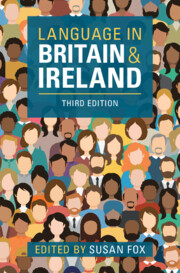Book contents
- Language in Britain and Ireland
- Language in Britain and Ireland
- Copyright page
- Contents
- Figures
- Tables
- Contributors
- Acknowledgements
- Map of Britain and Ireland
- Introduction
- Part I English
- 1 The History of English
- 2 Standard and Non-standard English
- 3 Phonetic and Phonological Variation in England
- 4 Grammatical Variation in England
- 5 Discourse-Pragmatic Variation in England
- 6 Scots and Scottish Standard English
- 7 English in Ireland
- 8 English in Wales
- 9 Insular Varieties of English in Britain
- 9 Insular Varieties of English in Britain
- 9 Insular Varieties of English in Britain
- 9 Insular Varieties of English in Britain
- Part II Multilingualism in Britain and Ireland: The Celtic Languages
- Part III Multilingualism in Britain and Ireland: Minority Languages
- Part IV Multilingualism: The Development of Urban Contact Varieties
- Part V Applied Sociolinguistic Issues
- Index
- References
2 - Standard and Non-standard English
from Part I - English
Published online by Cambridge University Press: 17 October 2024
- Language in Britain and Ireland
- Language in Britain and Ireland
- Copyright page
- Contents
- Figures
- Tables
- Contributors
- Acknowledgements
- Map of Britain and Ireland
- Introduction
- Part I English
- 1 The History of English
- 2 Standard and Non-standard English
- 3 Phonetic and Phonological Variation in England
- 4 Grammatical Variation in England
- 5 Discourse-Pragmatic Variation in England
- 6 Scots and Scottish Standard English
- 7 English in Ireland
- 8 English in Wales
- 9 Insular Varieties of English in Britain
- 9 Insular Varieties of English in Britain
- 9 Insular Varieties of English in Britain
- 9 Insular Varieties of English in Britain
- Part II Multilingualism in Britain and Ireland: The Celtic Languages
- Part III Multilingualism in Britain and Ireland: Minority Languages
- Part IV Multilingualism: The Development of Urban Contact Varieties
- Part V Applied Sociolinguistic Issues
- Index
- References
Summary
Observing that a linguistically principled characterisation of standard English remains elusive, this chapter explores the indeterminacy surrounding standard English, as well as reasons why a broad consensus on what it comprises is challenging to achieve. This indeterminacy is particularly acute with regard to the concept of standard spoken English, where uncertainty has been exacerbated by the failure of the prescriptive grammatical enterprise to acknowledge systematic structural differences between written and spoken English as well as formal and informal speech. Although linguistic accounts stress that standard English is best conceptualised as an abstraction to which actual usage conforms to a greater or less extent, there remains a gulf between academic and public understanding of the standard language. This disconnect facilitates the perpetuation of obfuscatory ideologies which inform public discourse about standard English. These include tenacious beliefs in the infallibility of its norms and its putative superiority to non-standard varieties, which are routinely dismissed as ‘incorrect,’ ‘vulgar’ and ‘uneducated’, when not altogether discounted as English. Empirically accountable analyses of naturally occurring discourse furnish an indispensable corrective to highly idealised prescriptive accounts of usage, which often fail to capture many of the implicit regularities of actual speech.
Keywords
- Type
- Chapter
- Information
- Language in Britain and Ireland , pp. 48 - 69Publisher: Cambridge University PressPrint publication year: 2024

